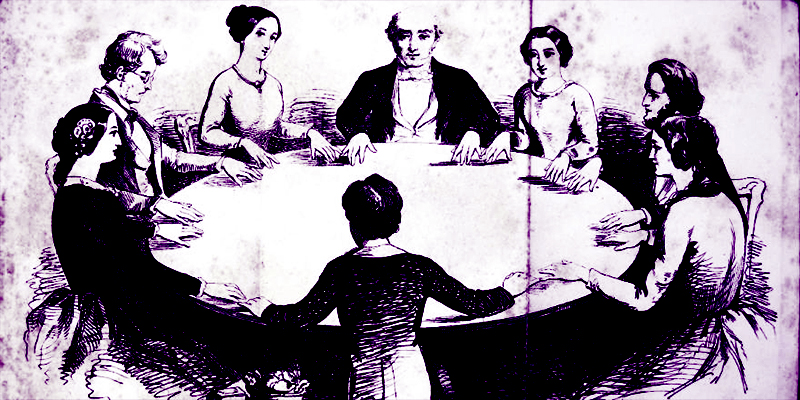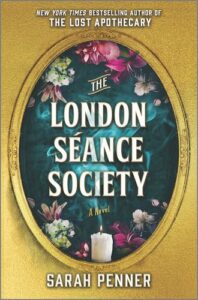The Victorians were fanatical about the dead. During this era, the spiritualist movement—central to which was communication with the dead, especially through mediums—was in its heyday. Victorians were fascinated by anything supernatural, otherworldly, or occult, and a number of our present-day traditions around death and dying echo the practices of this bygone era.
Public theatrical displays of mediumship and psychic power were a common occurrence in the Victorian era, particularly séances. These were an especially popular affair among the wealthy looking to entertain their friends with elaborate parlor-room displays.
Though the Victorians did not abide by any standard séance protocol, there were a few customary practices. The first was the person leading the séance: this would have been a self-proclaimed spiritualist, otherwise known as a medium. Most often, this was a woman. Spiritualism was one of the only professions in Victorian London in which women were more highly respected than men. Why? It was believed that a woman’s passivity, femininity, and intuition allowed her to access otherworldly realms more easily than a man, and because a man was considered less likely to submit to a spirit taking control of his psyche.
Once the medium had arrived on-site, séance participants were instructed to gather around a circular table and hold hands. Candles would be lit, and oil lamps turned low. Often, the medium would hang red drapery—believed to be conducive to spirit communication—around the room. The séance would generally begin with a prayer or petition, after which the medium could proceed with the affair as she so desired.
Some mediums liked to employ devices during their séances, such as a Ouija board or planchette. A planchette functions similarly to a Ouija board, except that a small pencil is mounted to it. As the participants move the planchette—presumably under the influence of spirits—the pencil writes, or draws, on a piece of paper, thereby communicating the spirit’s message.
Many mediums used a large cabinet, into which they would go for part or all of the séance. Here, mediums claimed to become entranced, or transfixed, by spirits. They would sometimes shout messages from inside the cabinet, or they might exit the cabinet claiming to be possessed at that very moment. Sometimes, these mediums would pretend to extract “ectoplasm”—a viscous, plasma-like substance—from various orifices of their body, like their ears or eyes, as tangible evidence of their entrancement.
If you’re feeling a bit skeptical reading this, you’re not alone. Indeed, the Victorian world of the occult was rife with fraud and ruses. Ectoplasm, for instance, could be easily made in a home kitchen with flour, water, cornstarch, and the like. There was no limit to the ploys pulled in the séance room: if people could be convinced, there was money to be made—and thus people willing to take advantage of that susceptibility.
Fraudsters often didn’t work alone. Dishonorable mediums were known to hire actors and ventriloquists to feign whispers from a corner of the room. Such mediums would also hire trick candlemakers to make fake candles in which the deceased’s perfume was embedded in the wax (imagine the surprise on a widow’s face when the room filled with her dead husband’s cologne!) Fraudulent spiritualists would even give a penny or two to young chimney boys, who would hide inside a chimney’s flue and make rapping sounds at predetermined intervals, leading participants to believe a spirit was knocking on the walls.
Mediums kept quite a few tools to assist with their hoaxes. Invisible ink and trick paper were common. Before a séance, a medium would write a message in invisible ink on a piece of paper. All she needed to do was flick a few drops of water onto the paper at an opportune time and, voila, the message was displayed. Spirit horns were common, too: this was nothing but a paper or wooden cone, which a medium would place to her ear. Picking up ambient noise, the medium would “interpret” these sounds as various messages from the deceased.
The ruses didn’t stop once a séance was over. After the event, fraudulent mediums often commissioned fake photographs of the event. Photography was in its infancy in the 1800s, and some mediums would ask photographers to superimpose images of people onto photographs of a séance room. This gave the impression of a translucent form hovering over a séance table, which could make for quite a convincing image.
Despite these many tricks and ploys, grieving people are desperate and often willing to believe anything. Logical as we humans can be, we are emotional, too, and the heart reigns. Confirmation bias—the tendency to interpret information in a way that supports one’s existing beliefs or desires—was often at play during Victorian séances, and participants were thus more likely to dismiss their skepticism in favor of belief.
My sophomore novel, THE LONDON SÉANCE SOCIETY, explores the Victorian’s obsession with the occult and the prevalence of ruses and tricks employed during séances. It tells the story of Vaudeline D’Allaire, an esteemed spiritualist known worldwide for her ability to conjure the spirits of murder victims to ascertain the identity of their killers. She and her apprentice, Lenna, take on a high-profile murder case and find themselves intertwined with an exclusive gentlemen’s-only organization in London, The Séance Society. This “boy’s club” also claims to perform séances, but as Vaudeline and Lenna team up with them, the women begin to suspect they are not merely out to solve a crime, but perhaps entangled in one themselves.
As with anything paranormal, we must always ask ourselves, what is real, and what is an illusion? Surely, many Victorians asked themselves this very question while sitting at the séance table. But given the popularity of spiritualism during this era and its adamant supporters—like Arthur Conan Doyle—it’s difficult to believe that the world of the paranormal is entirely an illusion. Might there be some halfway point, some happy medium? (pun not intended…)
As Lenna states at the end of THE LONDON SÉANCE SOCIETY, perhaps “the palpable could coexist with the invisible.” Scams aside, must we see to believe? Or are we willing to believe in something illusory and intangible? It’s an invitation to us all—as readers, grievers, skeptics and believers—to consider our own opinion on the matter, and what we value more: proof, or possibility.
***


















